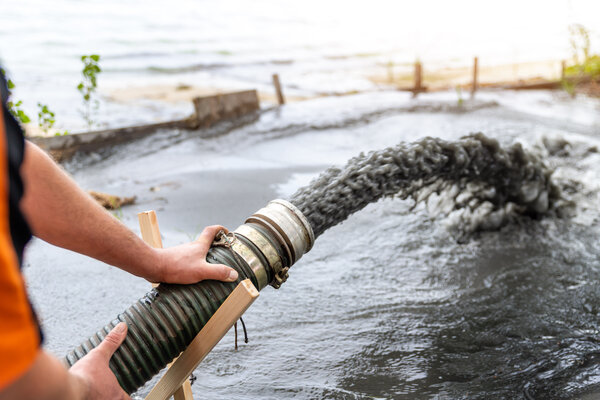[ad_1]
Liquid transfer pumps are essential pieces of equipment used across a wide range of industries to move fluids from one location to another. Whether it’s transferring water for irrigation, transporting chemicals in a manufacturing facility, or delivering fuel to vehicles, these pumps are crucial for ensuring the efficient and safe movement of liquids.
This article dives into the world of liquid transfer pumps, exploring their types, working principles, and diverse applications. Read on!
Understanding Liquid Transfer Pumps
Liquid transfer pumps are everywhere, quietly working behind the scenes—for instance, large industrial pumps transport oil and chemicals through pipelines and factories. Many people use smaller pumps for everyday tasks like pumping water from a basement during floods or moving drinks from barrels to bottles at breweries.
At its core, a liquid transfer pump uses mechanical or manual action to draw liquid in and push it out through a system of pipes or hoses. These pumps come in many varieties – from manual hand pumps to powerful electric or engine-driven models. The type you choose for your operation should depend on the liquid, the volume, how quickly it needs to move, and the setting in which it’ll operate.
Some pumps are designed for thick, viscous fluids like heavy oils, while others work best with thin liquids like water or beverages. For instance, KNF pumps are excellent options for transferring the mobile phase from a large to a small container and filling or emptying reactors or dissolution equipment.
Types Of Liquid Transfer Pumps
As mentioned, there are many types of liquid transfer pumps to choose from. Here’s a brief discussion of some of the main categories:
Centrifugal Pumps
Centrifugal pumps are a specialized type that uses a rotating impeller to move liquids. They’re excellent options when you need to transfer large volumes of liquids. For example, you’ll find them in water treatment plants, helping to pump massive amounts of water through the various filtration and treatment processes.
Also, manufacturing facilities can utilize them to move chemicals, solvents, and other liquids from one processing stage to the next because of their high-volume capabilities. Generally, these pumps have many industrial applications that are vital to moving large liquid quantities fast.
Positive Displacement Pumps
Positive displacement pumps trap a fixed amount of liquid and then force the trapped volume into the discharge pipe. This method makes them convenient for handling viscous liquids or those containing solids.
For instance, you’ll find these pumps in food processing plants, helping to transfer thick sauces or purees. They also come in handy for cosmetics manufacturing, where they can pump gooey creams and lotions.
Submersible Liquid Transfer Pumps
Submersible pumps operate while submerged in liquid. This design allows you to use them in various applications where you need to immerse the pump fully. For example, submersible pumps are commonly used in deep water wells to extract groundwater from significant depths below the surface.
You can also utilize them in septic tanks and sewage systems, where they can function while submerged in wastewater. Additionally, submersible pumps can handle high-pressure applications due to their robust, waterproof construction. This enables them to pump liquids at high pressures without issues.
Choosing The Right Liquid Transfer Pump
Choosing the right liquid transfer pump is crucial for efficient and effective fluid handling. With a wide variety of pumps available, selecting a compatible pump could be challenging.
Here are a few considerations for choosing suitable liquid transfer pumps:
Liquid Properties
When it comes to choosing the right liquid transfer pump, the properties of the liquid you’re dealing with play a significant role. For instance, is it a thin, watery fluid or something thicker and denser? The viscosity can impact pump performance and efficiency. You’ll also want to consider if the liquid contains solids or is prone to crystals forming – positive displacement pumps may handle these better than others.
Chemical compatibility is also crucial. Some liquids can corrode or damage certain pump materials over time. So, whether you’re transferring acids, solvents, or food products, ensure you match the pump to the liquid’s unique characteristics.
Flow Rate Requirements
Another significant factor in pump selection is your desired flow rate. If you need to move small amounts at a leisurely pace, a low-flow pump could be ideal. But to transfer significant volumes rapidly, you’ll want a high-capacity model.
For example, draining a residential swimming pool varies from pumping thousands of gallons per minute through an industrial process. Getting the proper flow rate ensures you can handle your liquid volumes efficiently without over- or under-performing.
Application and Environment
You must also consider the application and environment where the pump will operate. Specific pumps excel in particular settings depending on factors like portability needs, power sources available, and exposure to elements.
For instance, a battery-powered pump might be perfect for a remote agricultural installation without electrical hookups. Mobility, noise levels, and temperature extremes could also influence the ideal pump choice. By weighing your application’s unique requirements against different pump capabilities, you can make the most fitting selection.
Conclusion
Liquid transfer pumps are the unsung heroes of many industries and everyday tasks. From large-scale industrial applications to simple household chores, these versatile machines keep liquids moving efficiently. By understanding the different types of pumps available and the factors to consider, you can ensure you select the right tool for the job. With the right pump in hand, you can tackle any liquid transfer challenge with ease.
[ad_2]
Source link
